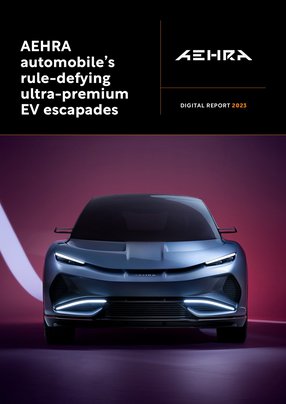AEHRA automobile’s rule-defying ultra-premium EV escapades
Since the mid-20th century, automotive has evolved around the chief component powering mobility—the engine. As the internal combustion engine (ICE) came to fruition, more and more car manufacturers centred their efforts around it to improve performance, increase fuel efficiency, and even to refine their engine sounds, appealing to the fast-driving, thrill-seeking car buyers out there.
When it comes to car design, the general trend—particularly among high-end, supercar builders—is the elongated front end to house ever growing engines, alongside other petrol and diesel components.
In an electrified world, this sort of front-elongated chassis won’t be necessary; EV infrastructure presents a unique opportunity to alter the way cars are designed and built.
Enter AEHRA, which took 2022 by storm when it introduced an SUV to the world that caters for many of the issues we see today in the automotive sector: emissions, unsustainable products, wasteful manufacturing processes, and globalised supply chains, the latter including ties to other organisations’ emissions reduction efforts.
Co-Founded by the company’s CEO, Hazim Nada, AEHRA enters into unchartered territory. The company leverages the electrical revolution to produce an ultra-premium EV with sustainable, localised credentials. The SUV was unveiled in the company’s home city of Milan, Italy, where the team astonished the crowd with the sheer stance and scale of the vehicle, which portrays the essence of Italian automotive innovation in a new generation of mobility.
There are many lessons to be learned from AEHRA’s story around the importance of passion within a team, commitment to sustainability, and innovative steps to be made in manufacturing sustainably—in particular, ensuring cars are infinitely recyclable—and doing so to meet the demands of high-end customers.
How it all began: AEHRA’s Italian automotive heritage
Nada himself is a well-educated man who chose to leave his previous role as an oil merchant and instead flip his career on its head. Despite this, it is the vision for AEHRA that caught the attention of some leading members of the Italian car community.
“The first challenge was convincing the engineering partners: many engineering firms have large-scale customers, so for them to entertain a small reality was the beginning. I then had to attract the right type of talent, getting people like Filippo Perini and all the other designers that we now have on board,” says Nada.
Having met with Perini trackside to discuss the idea, it’s safe to say that he took some initial convincing to consider the idea that Nada was proposing—a car with a shorter ‘nose’ that defies the conventional trend in the automotive sector. While the idea was still in its infancy at the time, Perini was the first critical stakeholder to challenge the proposal in order to encourage a more provocative approach to the aesthetics of the EV. This resulted in AEHRA not only redefining the car, but pioneering design.
Describing this stage of building the team means understanding the idea that Nada presented to his now colleague.
“It’s the first product that we’ve unveiled, but what I can say is that we’re committed to bringing out vehicles that are developed around the electric powertrain. If we go back in time to the 1920s and 30s, we’ll see that the automotive industry was experimenting with a lot of shapes, aerodynamics and whatnot.”
“All these trials have given way to what we see today with three-body architecture, because it’s the best architecture when it comes to accommodating the thermal and volumetric needs of internal combustion engines.
“This isn’t the same for electric vehicles. We see no reason to continue to utilise the shapes of the 70s, 80s, and 90s.”
AEHRA is, by definition, changing the game by leveraging more sustainable design principles that also accommodate EV architecture in the most intuitive way—giving way to the long nose of an ICE car and shortening the front end of its vehicles.
“The key element that we’ve done away with is the long hood—we’ve shortened the overhangs and developed this monobody architecture. This is the key element; AEHRA is redefining the shape of electric vehicles,” says Nada.
“By doing so, we’ve given a lot of character to the AEHRA SUV that you wouldn’t otherwise see in an electric vehicle. We’re also expanding the cabin space within the same volume of car, changing the customer experience.”
The three-metre-long stance of the SUV is one of its trademark attributes and, when combined with a significantly shorter front end, provides a substantial increase in space inside the car—enough space to comfortably fit four NBA players.
The luxury car with a sustainable conscience
Procurement is an important focal point of AEHRA’s efforts, as the company looks to reduce the number of bespoke components in the car—and even the car body itself.
The sustainable breakthrough can be seen in the monobody formation of the vehicle, which is made using sheet mould carbon (a carbon fibre process that is essential to the company’s production plans). From a material perspective, this is one of the highlights of the car. Using composite material means that the AEHRA SUV is not only made of recycled carbon fibre materials, but is also recyclable at the end of life.
“When it comes to the materials that we’re using, we will be the very first to conduct mass production of a vehicle of this size, these dimensions, utilising sheet mould carbon,” says Nada.
“The resulting structure that is produced within our process will be reutilised for at least five cycles after end of its life, resulting in weight savings by using such materials, which then translates into a direct energy saving that’s also enhancing sustainability.”
When it comes to sourcing the battery and other electrical components of the SUV, Nada assures us that negotiations are taking place to encourage a sustainable supply of equipment for the car. Having put such a strong emphasis on procurement allows the company to localise most of its supplier network and encourage production efforts closer to home.
“So far, we’re able to procure pretty much all of the components within the continent. Using composite materials means we have to stay as close as possible to Italy, because it’s the only country that contains the know-how and production capacity for such materials,” Nada explains.
The team taking on these challenges is one of Italian heritage. Nada himself reached out to some of the key innovators in the automotive world to tap into their expertise thus far. As of now, the production segment of the business will be led by its new Chief Engineering Officer. Plucked from the very heart of the automotive industry, Franco Cimatti is the latest to join the team in hopes that he will encourage the same disruptive ethos of its Founder.
“With over three decades in charge of engineering at Ferrari, and also about five years at Lotus, he’s a particularly important person, because he comes from the core of the vehicle dynamics experience—the top end of the internal combustion engine experience,” says Nada.
“He has also been in charge of fully electric platform developments at key houses like that of Lotus, so he’s a very important Italian figure and is able to marry all the key elements that we require.”
Nada believes that Cimatti’s presence will not only enhance the company’s ability to produce the car, but also influence the right talent that share the AEHRA ethos—and bring with them the Italian touch.
Technology-driven experience equals luxury
The firm recognises the growing trend for digital capabilities. One of the key benefits of the monobody architecture adopted by AEHRA is its capacity for a revolutionary cockpit experience.
As infotainment is a critical part of any high-end vehicle, the team is focusing on how it can make the SUV more intuitive, as well as make full use of the electrified platform and extra space inside the car.
One of the main drivers of the human-machine interface (HMI) design is consumers themselves. According to Nada, customers are less likely to want rear passenger screens due to nausea and discomfort—as well as the fact they probably already have one on their person.
The AEHRA will do the impossible and provide passengers a connected experience that allows the car to collaborate with other devices in the digital ecosystem.
“For the rear passengers, we are focusing on these types of experiences; personalised media solutions for each seat that can interact with such solutions. We’re not aiming to have screens in the back,” says Nada.
“The front row will be dominated by this particular screen solution, because it’s very unique and allows a level of productivity and entertainment that is impossible today.”
But the most important feature is the range—800km per charge—and that will be supported by the battery solutions. The battery pack itself will be somewhere “between 115 to 120kWh”. Though Nada states that “it will be closer to 120 with the solution that we’re currently developing and make use of NCM prismatic cells”.
The AEHRA story is one of technological, engineering and sustainable triumph packed into an EV that will likely evolve as time goes on and trends become ever-more digital.
Since the SUV made it into the media, the company has grown more determined than ever by the responses received across various platforms. The design of the vehicle itself is its main selling point, both to potential customers and the industry itself—in terms of being a feasible, thriving concept—the company has been praised for its exceptional work on the production-ready product. The time is now for AEHRA to secure the heart and soul of the daring automobile.
AEHRA’s aim for the near future is to finalise its negotiations with partners and suppliers to get them on board for the ride—a ride that will soon be split between two vehicles when AEHRA kicks its Sedan prototype development into gear.
“In April, we will ramp up the demonstration of the two vehicles together around the world. As soon as the saloon version is unveiled, we will begin our tour to market both vehicles,” says Nada. “Within the next six months, we need to identify a location to potentially internalise the final assembly. These locations will need to be affordable and workable.”
“When you place our sedan or the SUV close to a traditional vehicle, both really stand out; they’re very different. I think it will be difficult to go back to a traditional design once this is in production.”



